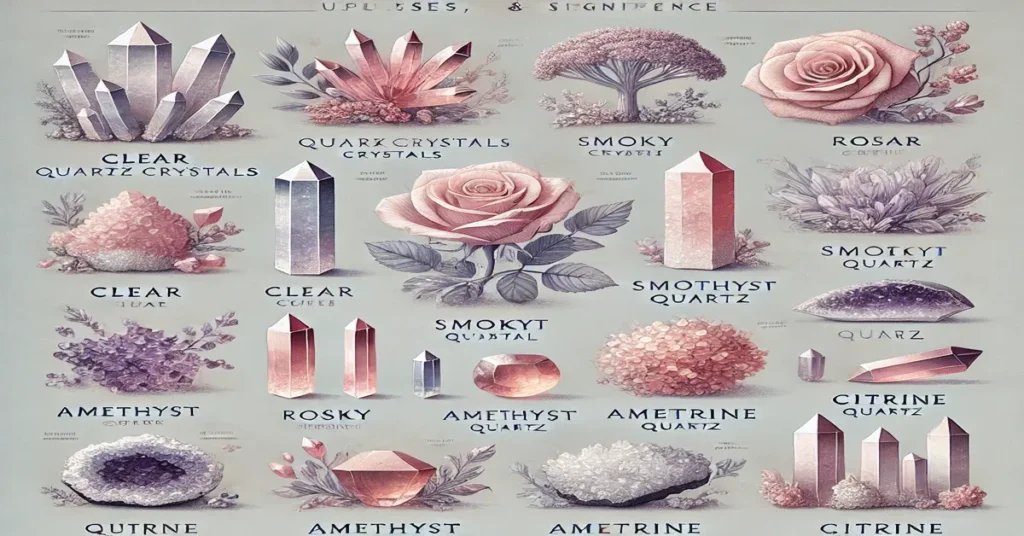Quartz, or “cuarzo” in Spanish, is a fascinating mineral that has captivated humanity for centuries. Known for its clarity, beauty, and versatility, quartz is one of the most common and widely used minerals on Earth. Whether it’s utilized in industrial applications, jewelry, spiritual healing, or energy amplification, quartz holds a special place across diverse cultures and industries.
This article will explore the many facets of cuarzo, from its physical properties and types to its applications and cultural significance. Whether you’re interested in quartz for scientific purposes, as a decorative element, or for its purported healing properties, this comprehensive guide provides everything you need to know about this remarkable mineral.
Table of Contents
- What is Cuarzo?
- Physical Properties of Quartz
- Types of Quartz
- Industrial Uses of Quartz
- Quartz in Jewelry and Decor
- Cultural and Spiritual Significance of Quartz
- The Science Behind Quartz Healing Properties
- How to Care for Quartz
- Conclusion
- FAQs
1. What is Cuarzo?
Cuarzo, or quartz, is a mineral composed of silicon and oxygen atoms (SiO₂) and is part of the silicate family of minerals. It is one of the most abundant minerals in Earth’s crust, making up about 12% of it. Quartz has a hardness of 7 on the Mohs scale, which makes it durable and resistant to scratching.
Due to its unique molecular structure, quartz can come in a variety of colors and forms. From transparent to opaque, from rose to smoky hues, quartz’s diversity makes it both beautiful and versatile.
2. Physical Properties of Quartz
Quartz’s physical properties are integral to its many uses in both scientific and decorative fields. Key properties include:
- Hardness: 7 on the Mohs scale, making it durable.
- Chemical Composition: Silicon dioxide (SiO₂).
- Transparency: Quartz can be transparent, translucent, or opaque.
- Piezoelectricity: Quartz can generate an electric charge when subjected to mechanical stress, a property known as piezoelectricity.
- Crystal System: Trigonal.
- Density: Around 2.65 g/cm³.
These properties make quartz an essential mineral in industries like electronics, timekeeping, and optics.
3. Types of Quartz
Quartz is a diverse mineral with many varieties. Here are some of the most common types of quartz:
a. Clear Quartz
- Known as “rock crystal,” clear quartz is highly transparent and valued for its purity. It is used in optics and electronics and is also believed to have powerful healing properties.
b. Rose Quartz
- Recognized by its pink hue, rose quartz is associated with love and compassion. It is commonly used in jewelry and as a healing stone.
c. Smoky Quartz
- Smoky quartz has a brown to black coloration and is believed to promote grounding and protection.
d. Amethyst
- Amethyst is a purple variety of quartz and is associated with spirituality and calm. It’s popular in jewelry and meditation practices.
e. Citrine
- Citrine has a yellow to orange hue and is often associated with prosperity and success.
f. Milky Quartz
- Known for its white, cloudy appearance, milky quartz is commonly found in large deposits and is used in industrial applications.
Each type of quartz has unique visual and metaphysical qualities, making it suitable for different uses and meanings.
4. Industrial Uses of Quartz
Quartz’s physical and chemical properties make it essential in various industrial applications. Key industrial uses include:
a. Electronics and Timekeeping
- Quartz’s piezoelectric properties allow it to generate an electric charge under pressure, which is crucial in timekeeping (quartz watches) and electronics (oscillators and circuits).
b. Glass Making
- Quartz sand is a primary component in glass manufacturing. Due to its purity and durability, quartz-based glass is used in optics and laboratory equipment.
c. Construction Materials
- Quartz is a common ingredient in cement, concrete, and other building materials due to its durability.
d. Abrasives
- Ground quartz is used in abrasive materials like sandpaper due to its hardness.
Quartz’s versatility and abundance make it invaluable across industries, from electronics to construction.
5. Quartz in Jewelry and Decor
Quartz is widely used in jewelry and decor, thanks to its beauty and availability. Different types of quartz offer various aesthetic qualities, making it a popular choice for rings, necklaces, and decorative items.
a. Quartz in Jewelry
- Clear quartz, amethyst, citrine, and rose quartz are popular choices for jewelry. Each color and variety is associated with unique metaphysical properties, enhancing its appeal in the fashion and wellness industries.
b. Quartz in Interior Design
- Quartz crystals, geodes, and clusters are used to create stunning decor pieces. Quartz countertops are also a popular choice for kitchens and bathrooms due to their durability and aesthetic appeal.
The popularity of quartz in jewelry and decor is driven by its beauty, durability, and symbolic associations.
6. Cultural and Spiritual Significance of Quartz
Quartz has held cultural and spiritual significance across various cultures and traditions:
a. Ancient Civilizations
- Many ancient cultures believed quartz had magical properties. Ancient Egyptians, Greeks, and Romans used quartz in jewelry, amulets, and religious rituals, believing it had protective and healing powers.
b. Indigenous Practices
- Indigenous cultures in North and South America use quartz in ceremonies for healing and spiritual guidance. Quartz crystals are seen as tools for connecting with the spirit world.
c. Modern Spirituality
- In contemporary spiritual practices, quartz is often associated with energy healing. Clear quartz is believed to amplify energy, while other varieties like rose quartz are used for emotional healing.
7. The Science Behind Quartz Healing Properties
While quartz is widely believed to possess healing properties, scientific evidence on its effectiveness is limited. However, the placebo effect and personal beliefs often enhance its perceived benefits.
a. Energy Amplification
- Clear quartz is thought to amplify energy, and some practitioners use it in meditation and healing practices to enhance focus and positivity.
b. Emotional Healing
- Stones like rose quartz are used for emotional healing, often to promote self-love and compassion.
c. Grounding and Protection
- Smoky quartz is believed to have grounding properties, helping individuals feel more connected to the Earth.
Though these properties are largely anecdotal, quartz remains a popular choice for individuals seeking mental and emotional support.
8. How to Care for Quartz
Proper care is essential for maintaining quartz’s beauty and longevity, especially when it’s used in jewelry or decor. Here are some tips for caring for quartz:
- Cleaning: Use a soft cloth and mild soap. Avoid harsh chemicals, as they may damage the stone’s surface.
- Avoid Heat: Quartz can crack under extreme heat, so keep it away from high temperatures.
- Recharging and Cleansing: Many people believe that quartz crystals benefit from recharging. Popular methods include sunlight exposure, moonlight baths, and burying them in soil.
Caring for quartz is simple but essential to preserve its appearance and energy.
Conclusion
Quartz, or cuarzo, is a versatile and valuable mineral with a rich history, diverse applications, and cultural significance. From industrial uses to spiritual practices, quartz has earned its place as one of Earth’s most essential and cherished minerals. Whether you’re interested in quartz for its durability, beauty, or metaphysical properties, this remarkable mineral offers something for everyone.
Quartz continues to captivate scientists, jewelers, spiritual practitioners, and enthusiasts around the world. With its unique properties and abundant availability, cuarzo remains a timeless symbol of beauty, resilience, and energy.
FAQs
1. What is cuarzo made of?
Quartz, or cuarzo, is composed of silicon dioxide (SiO₂), a combination of silicon and oxygen.
2. What are the different types of cuarzo?
Popular types of quartz include clear quartz, rose quartz, smoky quartz, amethyst, citrine, and milky quartz.
3. How is cuarzo used in industries?
Quartz is used in electronics, glassmaking, construction, and abrasives due to its hardness and chemical properties.
4. Does cuarzo have healing properties?
Many believe quartz has healing properties, with each type offering unique benefits, though scientific evidence is limited.
5. How should I care for cuarzo?
Clean quartz with mild soap and a soft cloth. Avoid exposing it to extreme heat, and consider recharging methods if used for spiritual purposes.
6. Why is quartz popular in jewelry?
Quartz is durable, beautiful, and available in various colors, making it a versatile and affordable gemstone for jewelry.







